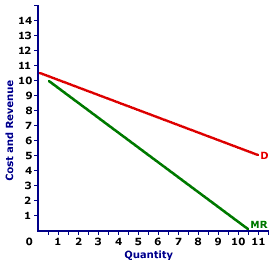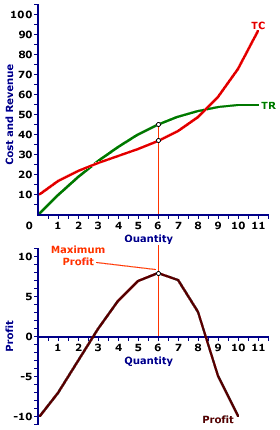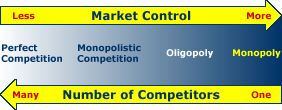
|
|
FARM PROBLEM: The short-run situation in which weather variability creates large fluctuations in farm prices, combined with the long-run situation in which technological advances increase production capabilities even though the demand for agricultural production declines relative to the growth of the overall economy. Taken together these two situations lead to highly unstable farm incomes that tend to decline over time. The solution to this problem has been significant government intervention in the agricultural industry, especially through assorted subsidies and price floors.
Visit the GLOSS*arama
|
|


|

|
                           MONOPOLY: A market structure characterized by a single seller of a unique product with no close substitutes. This is one of four basic market structures. The other three are perfect competition, oligopoly, and monopolistic competition. As the single seller of a unique good with no close substitutes, a monopoly has no competition. The demand for output produced by a monopoly is THE market demand, which gives monopoly extensive market control. The inefficiency that results from market control also makes monopoly a key type of market failure. Monopoly is a market in which a single firm is the only supplier of the good. Anyone seeking to buy the good must buy from the monopoly seller. This single-seller status gives monopoly extensive market control. It is a price maker. The market demand for the good sold by a monopoly is the demand facing the monopoly. Market control means that monopoly does not equate price with marginal cost and thus does not efficiently allocate resources.CharacteristicsThe four key characteristics of monopoly are: (1) a single firm selling all output in a market, (2) a unique product, (3) restrictions on entry into the industry, and (4) specialized information about production techniques unavailable to other potential producers.- Single Supplier: First and foremost, a monopoly is a monopoly because it is the only seller in the market. The word monopoly actually translates as "one seller." As the only seller, a monopoly controls the supply-side of the market completely. If anyone wants to buy the good, they must buy from the monopoly.
- Unique Product: A monopoly achieves single-seller status because the good supplied is unique. There are no close substitutes available for the good produced by a monopoly.
- Barriers to Entry: A monopoly often acquires and generally maintains single seller status due to restrictions on the entry of other firms into the market. Some of the key barriers to entry are: (1) government license or franchise, (2) resource ownership, (3) patents and copyrights, (4) high start-up cost, and (5) decreasing average total cost. These restrictions might be imposed for efficiency reasons or simply for the benefit of the monopoly.
- Specialized Information: A monopoly often possesses information not available to others. This specialized information comes in the form of legally-established patents, copyrights, or trademarks.
ReasonsMonopolies achieve their single-seller status for three interrelated reasons: (1) economies of scale, (2) government decree, and (3) resource ownership. While a monopoly can emerge and persist for any one of these reasons, most monopolies rely on two or all three.- Economies of Scale: Many real world monopolies emerge due to economies of scale and decreasing average cost. If average cost decreases over the entire range of demand, then a single seller can provide the good at lower per unit cost and more efficiently than multiple sellers. This often leads to what is termed a natural monopoly. The market might start with more than one seller, but it naturally ends up with a single seller that can best take advantage of decreasing average cost. Many public utilities (such as electricity distribution, natural gas distribution, garbage collection) have this natural monopoly inclination.
- Government Decree: The monopoly status of a firm can be established by the mandate of government. Government simply gives one and only one firm the legal authority to supply a particular good. Such single seller legal status is usually justified on economic grounds, such as an electric company that naturally tends to monopolize a market. However, it might also result from political forces, such as mandating monopoly status to a firm controlled by a campaign donor or close political associate.
- Resource Ownership: A monopoly is likely to arise if a firm has complete control over a key input or resource used in production. If the firm controls the input, then it controls the output. Monopolies have arisen over the years due to control over material resources (petroleum and bauxite ore), labor resources (talented entertainers and skilled athletes), or information resources (patents and copyrights).
Demand and RevenueDemand Curve,
Monopoly |  |
Single-seller status means that monopoly faces a negatively-sloped demand curve, such as the one displayed in the exhibit to the right. In fact, the demand curve facing the monopoly is the market demand curve for the product.The top curve in the exhibit is the demand curve (D) facing the monopoly. The lower curve is the marginal revenue curve (MR). Because a monopoly is a price maker with extensive market, it faces a negatively-sloped demand curve. To sell a larger quantity of output, it must lower the price. For example, the monopoly can sell 1 unit for $10. However, if it wants to sell 2 units, then it must lower the price to $9.50. For this reason, the marginal revenue generated from selling extra output is less than price. While the price of the second unit sold is $9.50, the marginal revenue generated by selling the second unit is only $9. While the $9.50 price means the monopoly gains $9.50 from selling the second unit, it loses $0.50 due to the lower price on the first unit ($10 to $9.50). The net gain in revenue, that is marginal revenue, is thus only $9 (= $9.50 - $0.50). Short-Run ProductionShort-Run Production,
Monopoly |  |
The analysis of short-run production by a monopoly provides insight into efficiency (or lack thereof). The key assumption is that a monopoly, like any other firm, is motivated by profit maximization. The firm chooses to produce the quantity of output that generates highest possible level of profit, given price, market demand, cost conditions, production technology, etc.The short-run production decision for monopoly can be illustrated using the exhibit to the right. The top panel indicates the two sides of the profit decision--revenue and cost. The hump-shaped green line is total revenue (TR). Because price depends on quantity, the total revenue curve is a hump-shaped line. The curved red line is total cost (TC). The difference between total revenue and total cost is profit, which is illustrated by the lower panel as the brown line. A firm maximizes profit by selecting the quantity of output that generates the greatest gap between the total revenue line and the total cost line in the upper panel, or at the peak of the profit curve in the lower panel. In this example, the profit maximizing output quantity is 6. Any other level of production generates less profit. A Few ProblemsThree problems often associated with a market controlled totally by a single firm are: (1) inefficiency, (2) income inequality, (3) political abuse.- Inefficiency: The most noted monopoly problem is inefficiency. Market control means that a monopoly charges a higher price and produces less output than would be achieved under perfect competition. In addition, and most indicative of inefficiency, the price charged by the monopoly is greater than the marginal cost of production.
- Income Inequality: A lesser known problem with monopoly is an inequitable distribution of income. To the extent that monopoly earns economic profit, consumer surplus is transferred from buyers to the monopoly. Buyers end up with less income and the monopoly ends up with more. In addition, because price is greater than marginal cost and a monopoly receives economic profit, factor payments to some or all of the resources used by the monopoly are greater than their contributions to production. A portion of this economic profit is often "paid" to the owners of the labor, capital, or land.
- Political Abuse: A third potential problem, one tied directly to the concentration of income by the monopoly resources, is the abuse of political power. The monopoly could use its economic profit to influence the political process, especially policies that might prevent potential competitors from entering the market.
The Other Three Market Structures| Market Structure Continuum |  |
Monopoly is one of four common market structures. The other three are: perfect competition, oligopoly, and monopolistic competition. The exhibit to the right illustrates how these four market structures form a continuum based on the relative degree of market control and the number of competitors in the market. At the far right of the market structure continuum is monopoly, characterized by a single seller and extensive market control.- Perfect Competition: To the far left of the market structure continuum is perfect competition, characterized by a large number of relatively small competitors, each with no market control. Perfect competition is an idealized market structure that provides a benchmark for efficiency.
- Oligopoly: In the middle of the market structure continuum, residing closer to monopoly, is oligopoly, characterized by a small number of relatively large competitors, each with substantial market control. A substantial number of real world markets fit the characteristics of oligopoly.
- Monopolistic Competition: Also in the middle of the market structure continuum, but residing closer to perfect competition, is monopolistic competition, characterized by a large number of relatively small competitors, each with a modest degree of market control. A substantial number of real world markets fit the characteristics of monopolistic competition.

Recommended Citation:MONOPOLY, AmosWEB Encyclonomic WEB*pedia, http://www.AmosWEB.com, AmosWEB LLC, 2000-2024. [Accessed: April 24, 2024].
Check Out These Related Terms... | | | | | | |
Or For A Little Background... | | | | | | | | | | | | | | |
And For Further Study... | | | | | | |
Search Again?
Back to the WEB*pedia
|



|

|
BLACK DISMALAPOD
[What's This?]
Today, you are likely to spend a great deal of time at a crowded estate auction hoping to buy either a flower arrangement with a lot of roses for your grandmother or a wall poster commemorating the first day of winter. Be on the lookout for poorly written technical manuals.
Your Complete Scope
This isn't me! What am I?
|

|
|
A scripophilist is one who collects rare stock and bond certificates, usually from extinct companies.
|

|
|
"The greatest things ever done on Earth have been done little by little. " -- William Jennings Bryan
|

|
CBOE
Chicago Board Options Exchange
|

|
|
Tell us what you think about AmosWEB. Like what you see? Have suggestions for improvements? Let us know. Click the User Feedback link.
User Feedback
|


|


